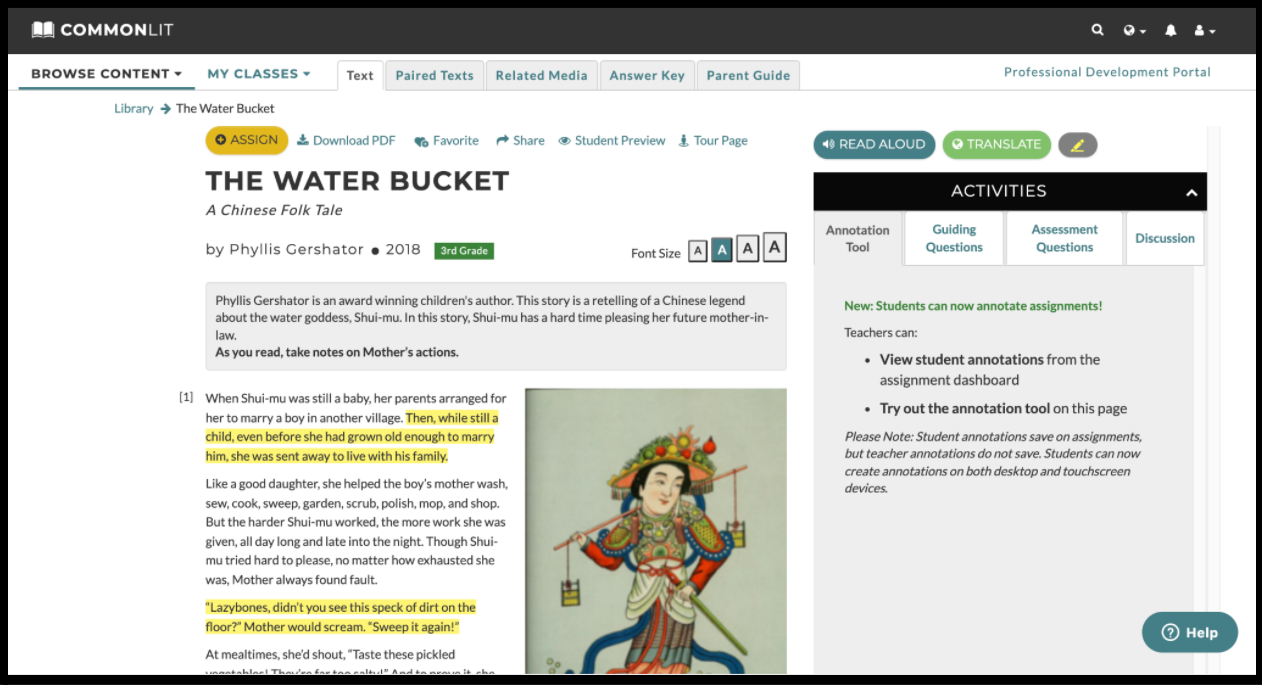Explore different cultures with these stories from around the world!
Reading myths and folktales is a great way to engage young learners. Since these tales were originally told to convey a moral or to explain an aspect of our natural world, they are perfect for students learning to determine theme and make text-to-world connections.
Here are twelve diverse myths and folktales for elementary students from cultures all over the globe!
“How the Stories Came to Be” by Mabel Powers (3rd Grade)
Start off a unit on folktales with a text about the Iroquois tribe’s tradition of storytelling! In the winter months, storytellers would go from wigwam to wigwam, sharing the oral histories of their tribe. Have students make text-to-self connections by brainstorming an oral history of their own. They could tell the story of a family tradition or a special memory. Then, have students take turns telling their stories in small groups.
“The Water Bucket: a Chinese Folk Tale” by Phyllis Gershator (3rd Grade)
In this retelling of a Chinese legend, Shui-mu lives in the home of her future husband’s family and must serve both him and his mother. She toils every day carrying buckets of water from the well to her home. One day, a mysterious woman gifts her with a bucket that refills itself. But then, things get out of hand when Shui-mu’s impatient mother-in-law tries to use it! Have students use the annotation tool to highlight the actions of the mother and son in the story. Then, have students use their notes to discuss the moral of the story.

“Stop the Hungry Giant Fish: Based on a Legend from the Island of Guam” by Pam Calvert (4th Grade)
In this tale from the Chamorros, the original inhabitants of Guam, a fish threatens to devour the island. The men, women, and children of the island must work together to defeat the massive fish before it’s too late! This is an excellent text to demonstrate the importance of working together. After reading, have students discuss a time when they had to overcome a challenge and needed the help of others. Use Discussion Question 1, “Describe a time when your community, whether that’s your friends, family, or classmates, had to come together to solve a problem.”
“The Sun, Moon, and Stars: A Traditional Navajo Story” by Donna Hennes (4th Grade)
In the past, folktales were told to explain natural phenomena. In this traditional Navajo story, the First People needed more light to see and keep warm. To help her people, the First Woman created the sun, moon, and stars. After reading, have students watch the Related Media video “Hopi Origin Story.” Ask them to compare and contrast these origin stories using evidence from the text and the video.
“Lazy Anansi” by Ghanian Folktale (4th Grade)
Students will love this Ghanian folktale about how the spider got its thin, spindly legs! Anansi is a spider who is too lazy to cook for himself, and so he depends on his friends to do it for him. One day, his plot to get free food goes wrong and he ends up terribly embarrassed! As they read, have students take notes on how Anansi interacts with his friends. Then, have students describe the lesson they think Anansi learned.

“Queen Minbe and the Cricket” by B. C. Bond (4th Grade)
In this tale from Korea, a queen with peculiar features seeks peace in her garden. Although she originally goes to her garden for quiet, she finds peace through an unexpected source instead. Students will enjoy this humorous tale of the queen’s quest for solitude! Have students make text-to-self connections by asking whether they like to have some quiet time, too. Have them list what they like to do when they want to relax.
“Why the Sky is Far Away” by Tina Tocco (4th Grade)
In this Nigerian folktale, the Sky was once a mere arm’s length away from the Earth, and the people took what they needed from the Sky. One day, the Sky grew angry at constantly giving and giving to the people, who were wasting its resources. The Sky threatened to leave forever if the people of Earth did not stop squandering the Sky’s bounty, and most people did — except for the greedy Osato. After reading, have students compare and contrast the themes in this text with the themes in “The Sun, Moon, and Stars,” a folktale that also describes the origin of natural phenomena. Students should use evidence from both texts to support their thinking.
“Yeshi’s Luck” by Naomi C Rose (4th Grade)
In this Tibetan tale, a father tries to teach his son, Yeshi, that luck is a matter of perspective. When his horse is stolen, Yeshi is convinced that he is in the midst of a string of bad luck. His father cautions him not to look at events as either good or bad luck. As students read, have them follow the annotation task, which asks them to take notes on how Yeshi’s father responds to the good and bad luck in their lives. Encourage students to discuss whether or not they agree with Yeshi’s father, or if they think people have good or bad luck.
“The Rich Man and the Bundle of Wood” by Maude Barrows Dutton (5th Grade)
In this tale from India, a greedy Rich Man refuses to pay a peasant full price for a bundle of wood. When the Priest questions his greed, the Rich Man again refuses to pay the Poor Man in full. That evening, an unfortunate event befalls the Rich Man that leaves him just as penniless as the Poor Man he snubbed. Encourage students to pay attention to the actions of the Rich Man in the text. After reading, show students the Related Media video “These People’s Generosity Will Give You All the Feels” and have them discuss how the Rich Man could have behaved differently.
“The Prophet Khizir” by Elizabeth Laird (5th Grade)
In this Iranian folktale, the great Shah has riches beyond imagination, but he only wants to see the miracles of the Prophet Khizir. When the palace proclaims that the person who can bring Khizir to the Shah will have whatever they desire, a poor man promises to find Khizir in exchange for money to feed his family. However, if the poor man fails to find the Prophet, he will be executed! As students read, have them follow the annotation task, which asks them to take notes on what motivates the poor man’s actions throughout the story. Then, ask them why they think Khizir finally appeared and spared the poor man from his fate.

“Mercury’s Sandals” by Rose Edwards (5th Grade)
In this story inspired by Greek and Roman mythology, young Arcela meets her new stepmom and step brother, Primus, for the first time during the festival celebrating Mercury, the messenger of the gods. Arcela and Primus struggle to see eye-to-eye almost immediately. While they argue with each other at Mercury’s temple, a strange figure makes off with Mercury’s enchanted sandals! After reading, have students make text-to-self connections. Ask Discussion Question 2, “In the story, the two siblings have to adjust to their new family. Have you ever had to make an adjustment in your life? What was the experience like?”
“The Talking Skull: A Fable from Cameroon” by Donna L. Washington (5th Grade)
In this fable from Cameroon, a man finds a talking skull on a walk. Astounded by this discovery, he immediately rushes to his village to share this wonder, but the villagers are frightened by the skull. When the chief of the village demands to know what is going on, the man shows him the skull and begs it to speak, but the skull says nothing. After he is thrown out of the village, the man asks the skull how he died in the first place. The skull’s answer: talking too much. After reading, have students read the fable “The Boy Who Cried Wolf” from our Paired Text section. Have students compare and contrast the lessons of each story using evidence from both texts.
Next Steps
Looking for more elementary myths and folktales on CommonLit? Browse the CommonLit Elementary Fairytales & Folktales Text Set and check out the full CommonLit library!
If you’re interested in learning all about CommonLit’s free digital literacy program for secondary students, join one of our upcoming webinars!


